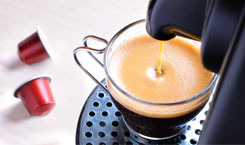Capsule machines
Coffee capsule machines have many advantages. Colloquially, the term capsule machine is used to describe single-portion coffee machines that prepare a hot drink with coffee pads or capsules. The operation is very simple: You fill the water tank of the machine, insert an espresso pad or capsule, press start and get an espresso or coffee.
Advantages of capsule and pad machines
The fact that the small, modern capsule or pad machines have general advantages is obvious. In contrast to the filter coffee machine, only the required amount of coffee is brewed. Operating capsule machines is much easier and faster than eliciting a good espresso from a strainer. In addition, the purchase costs for a capsule machine are usually much lower. Even those who like variation and tasting are well served with a capsule machine, most suppliers have a wide range of coffees for their machines, and mostly in practical quantities.
Disadvantages of capsule and pad machines
Despite the advantages, the disadvantages of the small machines are also quite obvious. Depending on the system and brand, the price for the complex capsules or pads can exceed that of normal espresso beans or ground coffee many times over. At least with capsule machines, the waste generated during use is a burden on the environment. Recycled or compostable capsules are virtually non-existent on the market. The city of Hamburg has therefore approved a general ban on single-portion machines for all official and public authorities.
Basically, a distinction is also made between the individual coffee systems according to so-called closed or open systems. In closed systems, the consumer can only use capsules from one manufacturer in his capsule machine, while in open systems a large number of roasters offer capsules or pads for one system. The advantage of the open system is obvious. Due to the competition, the consumer can choose from a variety of varieties and price segments.
There are now countless capsule and pad systems on the market. Some can only prepare espresso, others have a range that goes from espresso to coffee cream to cocoa. In order not to lose the overview, we have written a small compilation of the most common systems for you.
Nespresso®
Probably the best-known capsule system is the Nespresso® system introduced by Nestlé in the 1980s. Already patented in Switzerland in 1976, the success of the now independent Nespresso® company was long overdue. It was not until the 2000s that the system became popular, above all through the well-known TV campaign with George Clooney.
Nespresso® is the most successful coffee system in the world, with its own branches, countless types of capsules and, since 2011, numerous cooperations with roasters and machine manufacturers. Nespresso® capsules are made of aluminium, the capsule is filled with ground coffee and sealed with an aluminium membrane. The capsule is inserted into a Nespresso® machine, which perforates the top of the capsule by means of thorns when it is closed. Hot water is pressed into the capsule at high pressure until the underside tears open and the espresso runs into the cup. The patent for this system has now expired, transforming a closed system into an open system. Countless roasters have joined the system due to the millions of Nespresso® machines.
Key data
- 40-110 ml coffee
- 80-250€
- 20-80 ct
- Supermarket - yes
- Machines with milk frothers - yes
- Monopoly - no
Advantages
- Huge selection of capsules from different manufacturers
- High-quality capsule machines from various manufacturers
- Good Espresso, Lungo, Ristretto
- Good aroma protection due to airtight aluminium capsules
Disadvantages
- Sometimes high capsule price
- No milk drinks
- Original aluminium capsules are usually disposed of with household waste.
Lavazza Espresso Point
Like Nespresso, Espresso Point is a popular coffee system based on small black plastic capsules. The easy-to-use technology behind it was developed by Lavazza on the basis of Nespresso technology and marketed with a wide range of its own varieties. Since all patents on the capsules have expired a few years ago, numerous capsules can now be purchased from cheaper manufacturers.
In contrast to Nespresso capsules, Espresso Point capsules are not made of aluminium, but of polypropylene, now even compostable bio-plastics which are degradable. Lavazza attaches great importance to sustainability and environmental protection.
With numerous espresso varieties, lungos, creams, ritrettos and tea capsules, Lavazza now has something for every taste.
Key data
- 40-220ml
- 100-900€
- 20-75ct
- Supermarket - conditional
- Machines with milk frothers - yes
- Monopoly - no
Advantages
- Large selection of varieties and manufacturers
- Different capsule sizes (one or two cups)
- High-quality machines from various manufacturers
- Larger machines available especially for offices
- Good espresso etc.
- Good aroma protection
Disadvantages
- Limited availability at the supermarket
- Machines are sometimes too expensive for at home
Lavazza BLUE
Lavazza Blue capsule machines are available for every situation. From the compact espresso machine in the communal kitchen to large fully automatic machines for public areas, many different manufacturers produce different machine formats.
Although the capsules resemble the Nespresso system, they are not compatible. Depending on the manufacturer of the capsule, the capsule itself is made of plastic and the membrane is made of aluminium or plastic.
Key data
- 25-250ml
- 120-5000€
- 18-70ct
- Supermarket - rare
- Machines with milk frother - yes, even automatically
- Monopoly no
Advantages
- Large machines available for companies or public spaces
- Also available as a small version -> uniform system for large operations
- Often also available as leasing machine
- Powerful machines
- Even large quantities of capsules can be ordered normally
- Good aroma protection
Disadvantages
- Limited availability at the supermarket
- A little less choice, especially speciality coffees
- Often only available in large packs
E.S.E. Pads
E.S.E. stands for Easy Serving Espresso and is a standardized standard for coffee pads. This system was invented in the 70s by illy Caffe, a well-known company today. Originally, the pads were designed to fit into a screen holder. So the Baritsta could brew a decaffeinated coffee quickly. Soon afterwards, however, there were special ESE pad machines from e.g. Spinel. The system is open, not patented and freely accessible to every coffee roaster and machine manufacturer. This system enjoys great international popularity. Almost all Italian roasters have joined this system and offer the best espresso as an E.S.E. pad. Unfortunately, the distribution in Germany has not become so widespread, which is a pity. In our opinion it is the best coffee system. The Pads are packed under protective gas and are extremely fresh. The packaging of the individual pads can be in the yellow bag and the used pad itself in the compost.
The result in the cup is by far the best of all systems. This is due to the high pressure with which these machines work. The hot water is pressed through the very tightly packed and very fine grinding material. And is therefore the most similar to the process of a sieve carrier. This is the reason why the espresso almost comes close to the result of a small black from the sieve carrier.
The pads called Cialde in Italy consist of a 44mm wide filter bag made of paper and ground coffee, so they are 100% compostable. This makes them very sustainable and environmentally friendly compared to Nespresso and Lavazza capsules. It is also practical that there is no need to buy a new machine as there are screen carrier inserts for many classic screen carrier machines that can accommodate E.S.E. pads.
Espresso International offers a particularly large selection of E.S.E. Pads from top Italian roasters and various cultivating countries. We believe that E.S.E. technology, which produces excellent espresso with densely packed pads, is the best choice of pads. Our A-Z E.S.E. directory has the right espresso pad for every taste!
Key data
- 20-100ml
- 60-5000€ (expensive screen carrier machines)
- 15-70ct
- Supermarket - yes
- Machines with milk frothers - yes
- Monopoly - no
Advantages
- No brand or manufacturer commitment
- Huge selection of coffees and machines
- Compatible with screen carrier machines
- Good aroma protection when individually packaged
- Sustainable production
- Environmentally friendly, compostable pads
- No contact between aluminium or plastic and hot water
Disadvantages
- No brand commitment - there are also bad E.S.E. pads (not with us)
- Pads that are not individually wrapped can lose their aroma over a longer period of time.
Dolce Gusto
Also from Nestlé is the popular Dolce Gusto system. The Dolce Gusto system is very similar to the Nespresso systems in its functionality and has some special features. The special design of the capsules makes it possible to prepare milk-based coffee specialities, such as Latte Macchiato capsules. The Dolce Costa system thus fulfils the same function as a fully automatic coffee machine. The capsules contain milk powder, coffee powder and sugar. Normal espresso capsules are of course also available for the Dolce Gusto System.
Key data
- 100-1000€
- 20-250ml
- From approx. 40ct
- Supermarket - partly
- Machines with milk frothers - yes
- Monopoly - Basically no more since 2016
Advantages
- Super easy preparation of dairy beverages
- Good aroma protection
- Large selection of hot drinks
Disadvantages
- In comparison quite small selection of capsule suppliers

